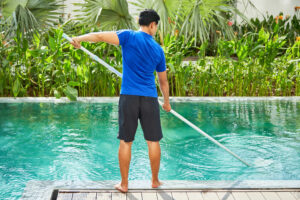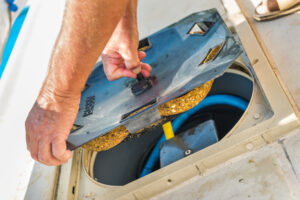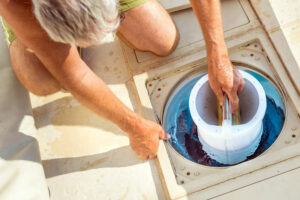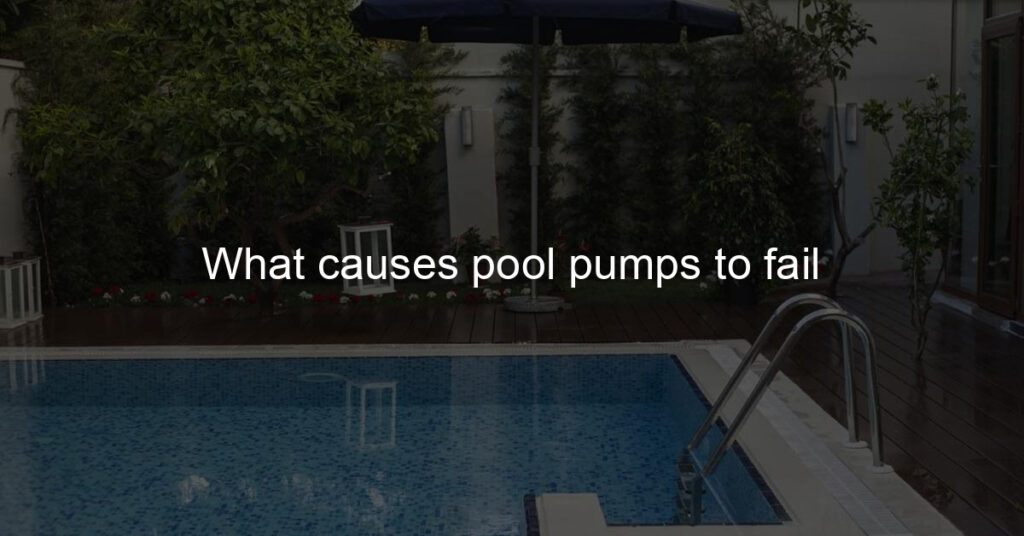Are you frustrated with your pool pump not functioning correctly? Are you seeing expensive utility bills because of malfunctioning parts? No one wants to deal with the headache (not to mention the costs!) of a failing pool pump.
Understanding the Components of a Pool Pump
A pool pump is made up of several key components, each serving a unique purpose. These parts include the motor, impeller, strainer basket, and housing. The motor powers the pump and is typically encased to protect it from weather conditions and water exposure. The impeller, driven by the motor, creates a suction force that pulls water into the pump.
The strainer basket catches large debris before water reaches the impeller, preventing clogs. Finally, the pump housing contains all these components. Understanding these parts can help diagnose potential issues when the pump is not working correctly. For instance, a noisy motor might suggest an electrical problem or worn bearings, while poor water flow could indicate a blocked strainer basket or impeller.
Essential Steps in Pool Pump Maintenance
Maintaining your pool pump is crucial to ensure it runs efficiently and lasts longer. Regularly clean out the strainer basket to prevent clogs, ensuring the pump can pull water in smoothly. It’s also important to check the pump seals for any signs of leaks, as these could lead to water entering the motor casing, causing it to malfunction or fail.
Keep an eye on the motor’s temperature during operation. If it’s running too hot, it could indicate that the pump is working harder than it should, often due to a blocked impeller or clogged filter. Finally, make sure the electrical connections are clean, secure, and free from corrosion.
Troubleshooting Common Pool Pump Problems
When you experience pool pump problems, it’s often beneficial to try and troubleshoot the issues before calling a professional. If the pump isn’t turning on, check the power supply and circuit breaker. If the pump is excessively noisy, it could be due to worn bearings, which may require replacement.
If the pump is overheating, check for a clogged strainer basket or filter. Water leaks around the pump could indicate faulty seals, which would need replacing. Keep in mind, however, if you’re uncomfortable performing these tasks, it’s always better to call a professional.

DIY or Call a Professional? Knowing When to Seek Help
While some minor pool pump issues can be addressed through DIY methods, others require professional expertise. Simple tasks like cleaning out the strainer basket, replacing seals, or resetting the circuit breaker can be performed by most homeowners.
However, more complex problems, like electrical issues or worn-out motor bearings, often need professional attention due to the risks involved. It’s crucial to assess your comfort and skill level when deciding whether to DIY or call a professional.
Picking the Right Pool Pump for Your Pool
Choosing the right pool pump depends on several factors. First, consider your pool’s size and the volume of water it holds. Larger pools will require pumps with more horsepower to effectively circulate and filter the water.
Second, consider the type of pool you have – in-ground or above-ground – as they require different types of pumps.
Lastly, take into account your budget, energy efficiency requirements, and the pump’s noise levels. A variable-speed pump, though more expensive upfront, can save significant energy costs in the long run.
Tips for Extending the Life of Your Pool Pump
To extend the lifespan of your pool pump, regular maintenance is key. This includes cleaning out the strainer basket, checking seals for leaks, and ensuring the pump’s electrical connections are secure and corrosion-free. Running the pump for the recommended 8-10 hours a day instead of 24/7 can also significantly reduce wear and tear.
During cooler months or times when the pool is not in use, consider reducing pump operation hours to save energy and prolong its life. Proper winterization of the pump is also crucial in colder climates to prevent freezing and related damage.
Effective Ways to Reduce Your Pool Pump Energy Consumption
Reducing the energy consumption of your pool pump not only saves money but is also better for the environment. Upgrading to a variable-speed pump is a great first step. These pumps adjust their speed based on the pool’s needs, saving a significant amount of energy compared to single-speed models.
Running your pump during off-peak hours, when electricity rates are typically lower, can also result in savings. Limiting your pump’s operation to the recommended 8-10 hours per day will also help cut down on energy consumption. Ensuring regular maintenance can also lead to energy savings, as a well-maintained pump operates more efficiently.

The Cost of Ignoring Pool Pump Maintenance
Ignoring pool pump maintenance can lead to a host of problems that will likely cost you more in the long run. A poorly maintained pump is less efficient, meaning higher energy costs. It’s also likely to have a shorter lifespan, leading to replacement costs sooner than expected. Ignoring regular maintenance could result in small issues becoming major problems.
For instance, a neglected leak could eventually damage the motor, leading to a costly repair or replacement. In addition, a poorly functioning pump may not effectively circulate and filter your pool water, resulting in poor water quality and potentially expensive chemical treatments.
Seasonal Care: Adjusting Pool Pump Usage in Different Climates
The climate and season can greatly impact how you use and maintain your pool pump. In warmer climates where pools are used year-round, pool pumps will need to run consistently, although perhaps not as long in cooler months. In contrast, pools in cooler climates that are closed for the winter require proper winterization of the pump to prevent damage.
This typically includes draining the pump, cleaning it thoroughly, and storing it in a dry, frost-free location. Additionally, in periods of heavy rainfall or after a storm, you may need to run the pump more frequently to keep the water clean.
What to Do When Your Pool Pump Fails: An Emergency Checklist
When your pool pump fails, it’s important to act quickly to prevent further damage. Start by switching off the power supply to the pump to prevent electrical accidents. Check the pump for visible damage or leaks.
If the pump isn’t turning on, inspect the circuit breaker, and reset if necessary. If the pump is still not working, you may need to call a professional. To prevent your pool water from stagnating, you could consider manually cleaning it or using a standalone pool filter until the pump is fixed.
Recycling and Disposing of a Failed Pool Pump: An Eco-friendly Approach
When a pool pump has reached the end of its life, it’s important to dispose of it in an environmentally friendly way. Some components, like the electric motor and metal casing, are often recyclable. Contact your local waste disposal facility to see if they accept these items. Some pool equipment manufacturers and retailers also offer take-back programs, where they’ll dispose of old equipment responsibly when you buy a new item.
By properly recycling and disposing of your old pool pump, you’re helping to reduce waste and protect the environment.

What can cause a pool pump to stop working?
Pools are a great way to cool off during hot summer days, but sometimes our pool pumps can fail us! Many different situations can cause a pool pump to stop working, including electrical issues with the wiring, power interruption, or clogged pipes and filters.
Additionally, environmental factors like heat and heavy rain can drastically reduce their performance due to overheating or water infiltration into the motor casing. It’s important to keep an eye out for any operational signs that could be telling you something’s not right, such as cooling fans running continuously or humming noises coming from the motor.
Taking preventive measures such as regular maintenance checks and cleaning your filter regularly can help ensure that your pool is always up and running!
What are the signs of a pool pump failing?
Knowing the common signs of a pool pump failing can help you take proactive steps before they become a major problem. If your pool pump is struggling to turn on or off, or producing a strange or loud noise, it could be an indication that something is wrong.
Additionally, if your pool water isn’t flowing properly and the circulation seems weak, this could also point to the pool pump not functioning correctly. If it shuts off abruptly and won’t work again until it cools down, then the motor may be overheating due to a malfunction.
Greater energy bills are another telltale sign, as the pool pump requires more energy when it’s not working efficiently. Finally, any leakage from the motor housing means there may be external damage that needs repair. By spotting these red flags and acting quickly your maintenance costs will remain low and your time spent in the pool enjoyable.
What causes a pool pump to burn out?
Pool pump burnouts can be incredibly frustrating – not only is your equipment damaged but it could also lead to costly repairs. The most common cause of a pool pump burning out is the motor becoming too hot.
This usually happens when the pump has been running for too long, or if something is blocking it from circulating properly, such as a clogged filter or a dirty impeller. Other causes include loose electrical connections or inadequate insulation on wires and cords.
It’s important to take preventative action so that you don’t have to deal with these issues in the future, like avoiding overworking your pump and ensuring that all electrical outlets are properly insulated and grounded.
How long do pool pumps usually last?
Pool pumps are an essential part of any swimming pool, as they keep it healthy and hygienic. But how long do they last? It depends on the quality of the pump and how often you maintain it.
Generally speaking, a properly-maintained pool pump can last for 8 to 12 years before needing replacement. However, if the motor or filter is worn out from overuse, regular cleaning might only extend its life to 4-5 years.
So if you’re looking for one that’ll make it through more than a decade, be sure to purchase a good quality pool pump from a trusted manufacturer and maintain it according to their recommendations!
Is it okay to run the pool pump all day?
With the heat of the summer months, running your pool pump all day can be a tempting way to keep that water cool and clean. But it is important to pay attention to how long you are running your pool pump — this appliance is not meant to be operated all day, every day.
It’s best to set a timer and limit running time to between eight and ten hours per day to help conserve energy, reduce running costs, and extend the life of the pump and filter system.
Assuming you are keeping up with regular maintenance and taking other preventative measures, such as making sure chemicals are properly balanced, your pool should still stay clean enough for swimming even with less pumping time.

How many hours a day should you run a pool pump?
Running a pool pump is an important part of keeping your pool clean and clear, but did you know that running it for too long can be damaging to your system?
To make sure all the potential bacteria and debris are properly filtered out while also avoiding unnecessary wear and tear on your pump, most experts recommend running your pump for 8-10 hours a day.
This will help keep your water healthy and make sure all the parts inside stay in good shape. For the best balance between efficiency and safety, stick to these recommended hours per day when running a pool pump.
Conclusion
Taking care of your pool pump is an essential part of pool ownership. From understanding the key components to implementing regular maintenance schedules, being proactive can extend the life of your pump and maintain the quality of your pool water. The importance of choosing the right pump for your pool cannot be overstated, as it can significantly impact energy consumption and operating costs.
By following best practices, you can troubleshoot common issues, understand when to seek professional help, and ensure your pump operates efficiently. Regular adjustments to pool pump usage based on seasonal and climatic changes can also contribute to more effective functioning. Remember, an underperforming or failing pump can result in increased energy costs and reduced water quality, so prompt action is crucial.
When a pool pump finally fails, knowing how to react and having an emergency plan in place will help minimize the impact on your pool. Even at the end of its lifecycle, an eco-friendly approach to disposal can help mitigate environmental impact. In conclusion, pool pump management is an ongoing task, but with knowledge and regular attention, you can enjoy a clean and sparkling pool for many years.














